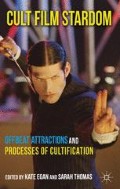Abstract
Work on cult media has often tended to explore the role of textual qualities (Eco 1995) and authorship (e.g. Hutchings 2003) in the cultification process. Stardom, however, has been significantly under-explored in relation to discourses of cult. Just as constructions of cult status can be multiple around a single text, for example taking in novelistic authors and filmic auteurs (Hills 2011), so too might stardom work in a variety of ways in relation to cult discourses.
Access this chapter
Tax calculation will be finalised at checkout
Purchases are for personal use only
Preview
Unable to display preview. Download preview PDF.
References
Black, David A. (2004) ‘Charactor; or, The Strange Case of Uma Peel’, in Sara Gwenllian-Jones and Roberta E. Pearson (eds), Cult Television. Minneapolis: University of Minnesota Press, 99–114.
Brottman, Mikita (2000) ‘Star Cults/Cult Stars: Cinema, Psychosis, Celebrity, Death’, in Xavier Mendik and Graeme Harper (eds), Unruly Pleasures: The Cult Film and its Critics. Guildford: FAB Press, 105–19.
Burchill, Julie (1986) Damaged Gods. London: Century.
Campbell, Bruce (2009) If Chins Could Kill: Confessions of a B Movie Actor. London: Aurum Press.
Cohan, Steven (2001) ‘Judy on the Net: Judy Garland Fandom and “the gay thing” Revisited’, in Matthew Tinkcom and Amy Villarejo (eds), Keyframes: Popular Cinema and Cultural Studies. London and New York: Routledge, 119–36.
Cohen, Ira J. (1989) Structuration Theory: Anthony Giddens and the Constitution of Social Life. Basingstoke: Macmillan.
Dyer, Richard (1986) Heavenly Bodies: Film Stars and Society. London: BFI.
Eco, Umberto (1995) Faith in Fakes: Travels in Hyperreality. London: Minerva.
Gledhill, Christine (ed.) (1991) Stardom: Industry of Desire. London and New York: Routledge.
Hauer, Rutger (with Patrick Quinlan) (2008) All Those Moments: Stories of Heroes, Villains, Replicants and Blade Runners. New York: Harper Entertainment.
Hills, Matt (2002) Fan Cultures. London and New York: Routledge.
— (2003a) ‘Recognition in the Eyes of the Relevant Beholder: Representing “Subcultural Celebrity” and Cult TV Fan Cultures’, Mediactive, Vol. 2: 59–73.
— (2003b) ‘Star Wars in Fandom, Film Theory, and the Museum: The Cultural Status of the Cult Blockbuster’, in Julian Stringer (ed.), Movie Blockbusters. London and New York: Routledge, 178–89.
— (2006) ‘Realising the Cult Blockbuster: The Lord of the Rings Fandom and Residual/Emergent Cult Status in “the Mainstream”’, in Ernest Mathijs (ed.), The Lord of the Rings: Popular Culture in Global Context. London and New York: Wallflower Press, 160–71.
— (2008) ‘The Question of Genre in Cult Film and Fandom: Between Contract and Discourse’, in James Donald and Michael Renov (eds), The Sage Handbook of Film Studies. Los Angeles and London: Sage, 436–53.
Hills, Matt (2010) ‘Subcultural Celebrity’ in Stacey Abbott (ed.) The Cult TV Book. London and New York: I.B. Tauris: 233–38.
— (2011) Cultographies: Blade Runner. London and New York: Wallflower Press.
Hutchings, Peter (2003) ‘The Argento Effect’, in Mark Jancovich, Antonio Lazaro Reboll, Julian Stringer and Andy Willis (eds), Defining Cult Movies. Manchester and New York: Manchester University Press, 127–41.
Jerslev, Anne (1992) ‘Semiotics by Instinct: “Cult Film” as a Signifying Practice between Audience and Film’, in Michael Skovmand and Kim Christian Schroder (eds), Media Cultures. London and New York: Routledge, 181–98.
— (2006) ‘Sacred Viewing: Emotional Responses to The Lord of the Rings’, in Ernest Mathijs (ed.), The Lord of the Rings: Popular Culture in Global Context. London and New York: Wallflower Press, 206–21.
Loreti, Nicanor (2010) Cult People: Tales from Hollywood’s Exploitation A-list. Milton Keynes: Headpress.
Marshall, P. David (1997) Celebrity and Power: Fame in Contemporary Culture. Minneapolis: University of Minnesota Press.
Mathijs, Ernest (2011) ‘Referential Acting and the Ensemble Cast’, Screen, Vol. 52, No. 1: 89–96.
Mathijs, Ernest and Jamie Sexton (2011) Cult Cinema: An Introduction. Malden and Oxford: Wiley-Blackwell.
McCarthy, Soren (2003) Cult Movies in Sixty Seconds. London: Fusion Press.
McDonald, Paul (2000) The Star System: Hollywood’s Production of Popular Identities. London and New York: Wallflower Press.
McKee, Robert (1999) Story. London: Methuen.
O’Toole, Lawrence (2008) ‘The Cult of Horror’, in Ernest Mathijs and Xavier Mendik (eds), The Cult Film Reader. Maidenhead and New York: Open University Press, 257–62.
Parker, John (2000) Structuration. Buckingham and Philadelphia: Open University Press.
Rodman, Gilbert (1996) Elvis After Elvis: The Posthumous Career of a Living Legend. London and New York: Routledge.
Sandvoss, Cornel (2005) Fans: The Mirror of Consumption. Cambridge and Boston: Polity Press.
Smith, Justin (2005) ‘Things that go Clunk in the Cult Film Text: Nodes and Interstices in The Wicker Man’, in Jonathan Murray, Lesley Stevenson, Stephen Harper and Benjamin Franks (eds), Constructing The Wicker Man: Film and Cultural Studies Perspectives. University of Glasgow: Crichton Publications, 123–38.
— (2010) Withnail and Us: Cult Films and Film Cults in British Cinema. London and New York: I. B. Tauris.
Sternheimer, Karen (2011) Celebrity Culture and the American Dream: Stardom and Social Mobility. New York and London: Routledge.
Turner, Graeme (2004) Understanding Celebrity. London: Sage.
Editor information
Editors and Affiliations
Copyright information
© 2013 Matt Hills
About this chapter
Cite this chapter
Hills, M. (2013). Cult Movies With and Without Cult Stars: Differentiating Discourses of Stardom. In: Egan, K., Thomas, S. (eds) Cult Film Stardom. Palgrave Macmillan, London. https://doi.org/10.1057/9781137291776_2
Download citation
DOI: https://doi.org/10.1057/9781137291776_2
Publisher Name: Palgrave Macmillan, London
Print ISBN: 978-1-349-33305-9
Online ISBN: 978-1-137-29177-6
eBook Packages: Palgrave Media & Culture CollectionLiterature, Cultural and Media Studies (R0)

